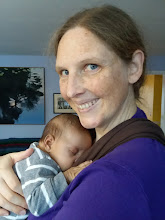Back in the jungle
The storm has moved on, leaving the air thick with humidity and the trees dripping. A few parrots are squabbling over fruit in the high branches. About an hour ago the dark clouds came rumbling down from the Cordillera Volcanica Central trailing streamers of rain, and a few flashes of lightning close by convinced me to unplug the computer and take a break from preparing data sheets for the upcoming field surveys. As you might have guessed, I’m back in the jungle, specifically at Finca Los Nacientes in San Ramón de La Virgen, Sarapiquí, Costa Rica.
The biggest change since the last time I visited the farm was the arrival of baby Isabel. She is a remarkably sweet and calm four-month-old with a spiky cap of red hair just like Alex’s and deep brown eyes sparkling with curiosity like Felix’s. Life at the farm continues in a similar rhythm: rising with the dawn, a breakfast of gallo pinto (rice and beans), fried plantains, eggs, and coffee; long days in the field; a second round of coffee and some cake when the storms roll in mid-afternoon; dinner and an early bedtime. Felix’s cousin Yerlin looks after the baby during the day so Alex can get some work done. I’ve heard that a baby’s rate of vocabulary acquisition depends on how many words she hears in her early years, and if that’s the case Isabel will probably be off the charts: Yerlin is a talker.
Yesterday morning Alex and I went to the forest for a few hours to take leaf longevity measurements. For the last three years, she and Felix have marked the emerging leaves of new seedlings with little plastic tags when they emerge, and she revisits them every month to measure the leaf life span. It’s basic science, but with an eventual applied goal—the more we know about how these species behave in different conditions, the better we can plan for reforestation.
It was a hot morning after a night of rain. The red earth of the hillside steamed where slashes of sunlight came down through the canopy, and the thick odor of rotting leaves surrounded us. Being back in the forest always puts my senses on full alert: snakes? ants? scorpions? Nearly a decade ago now, during my first semester in graduate school, I visited the American Museum of Natural History with my systematics class right after three months in the jungle. There was an exhibit of live butterflies inside a climate-controlled tent. I remember that the minute I walked in and felt that air, 85 degrees F and 95% humidity, full of the humid smell of decaying vegetation, all of a sudden I was fully aware of where my hands and feet were and what was around me: snakes? ants? scorpions? It’s not paranoia; it’s more like a sharpened awareness that makes me feel fully alive and present.
Between two sets of plots yesterday, Alex and I paused at the trail junction for water and some oatmeal raisin cookies. Filthy, muddy, sweaty, swatting mosquitoes, we started chatting about biostatistics. There may have been other people in the world at that very moment sitting in the rainforest talking about model selection and the Akaike Information Criterion, but probably not many. And probably very few of them were as happy as I was. It’s good to be back.


0 Comments:
Post a Comment
<< Home